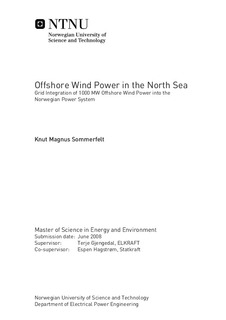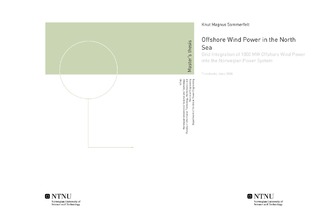| dc.contributor.advisor | Gjengedal, Terje | nb_NO |
| dc.contributor.advisor | Hagstrøm, Espen | nb_NO |
| dc.contributor.author | Sommerfelt, Knut Magnus | nb_NO |
| dc.date.accessioned | 2014-12-19T13:52:35Z | |
| dc.date.available | 2014-12-19T13:52:35Z | |
| dc.date.created | 2011-06-27 | nb_NO |
| dc.date.issued | 2008 | nb_NO |
| dc.identifier | 426907 | nb_NO |
| dc.identifier | ntnudaim:4265 | nb_NO |
| dc.identifier.uri | http://hdl.handle.net/11250/257026 | |
| dc.description.abstract | Norway has great potential for offshore wind power, but the depths just outside the coast probably make floating wind turbines necessary. In order to use today s technology for offshore wind turbines with foundations on the seabed, water depths cannot be much larger than 60 meters. It is possible to install the wind turbines at such depths, but the distance to these areas make AC cable transmission difficult because of the reactive power production in the cables. VSC HVDC is a technology well suited for offshore wind power, and HVDC Light is now commercially available for rating up to 1174 MW. Theory for VSC HVDC in systems in general is given first in the thesis. The case for this thesis is grid integration of a 1000 MW offshore wind farm into the Norwegian power system.PSS/E was used in simulations of grid integration of the offshore wind power. Two possible connection points in the south of Norway were found based on load flow simulations; Feda and Kårstø. Only a load flow situation with peak load and production in the isolated Norwegian power system was provided. Different load flow situations for the two connection points were established in order to investigate the dynamic response at the connection points for situations with lower load and production.A case with two sets of 100 km AC cables was used for the dynamic simulations as well as a HVDC Light link with a 600 km cable. SVCs were added at the connection point for the case with AC cable connection in order to fulfil the requirement for capacitive and inductive power factor at the connection point to the grid for wind power. No such compensation of reactive power is necessary for HVDC Light, as the converter can adjust the power factor. The voltage at the connection points is 300 kV. Dynamic simulations were done based on the fault ride through requirement from the Norwegian TSO Statnett for power plants connected to voltage level higher than 200 kV.Different disturbances were done in the power system onshore close to the two connection points. The simulations done with AC cables and SVCs for reactive power compensation showed that the power system was not able to return to a stable operating point in all the simulations. With HVDC Light on the other side, simulations showed that the voltage at the connection points recovered to the pre fault value in all the simulations. The voltage recovery was within the voltage profile defined in the fault ride through requirement, and the wind turbines had to stay connected.The wind farm was modelled as one equivalent generator offshore, and a standard PSS/E induction generator model was used. For the case with HVDC Light, the voltage offshore was practically unaffected by the disturbances onshore. The energy produced during the fault was stored as rotational kinetic energy in the wind turbine in order to avoid the DC voltage to increase drastically. This is an approximation done in this thesis. Wind projects planned with HVDC Light will have a DC chopper. A fault onshore will not affect the wind farm, as the power produced during the fault is dissipated in the DC resistance. | nb_NO |
| dc.language | eng | nb_NO |
| dc.publisher | Institutt for elkraftteknikk | nb_NO |
| dc.subject | ntnudaim:4265 | no_NO |
| dc.subject | MIENERG energibruk og energiplanlegging | no_NO |
| dc.subject | Energibruk og energiplanlegging | no_NO |
| dc.title | Offshore Wind Power in the North Sea: Grid Integration of 1000 MW Offshore Wind Power into the Norwegian Power System | nb_NO |
| dc.type | Master thesis | nb_NO |
| dc.source.pagenumber | 170 | nb_NO |
| dc.contributor.department | Norges teknisk-naturvitenskapelige universitet, Fakultet for informasjonsteknologi, matematikk og elektroteknikk, Institutt for elkraftteknikk | nb_NO |

